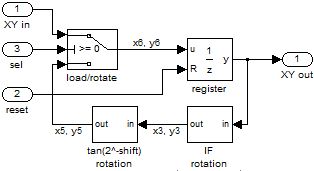This module rotates an I/Q vector through an angle whose tangent is a negative power of two in the spirit of the Cordic algorithm,
xn+1 = xn - 2−shift yn yn+1 = yn + 2−shift xn

requiring only additions and bit shifts. The module is intended for interpolation between waypoints where only a small rotation each time step is required. It does not preserve the vector's magnitude, but with these small angles magnitude may be preserved sufficiently well. Although it only implements a single power-of-two rotation, it may be cascaded to better approximate a given rotation, and in fact can be used in a pipelined Cordic implementation.
The module also implements I/Q up/down conversion via the IF parameter – 0 (no frequency translation), 90 (fs/4), 180 (inversion), and 270 (-fs/4).
Ports | Parameters | Notes | Example
| clk | input | The clock input. |
| reset | input | The reset input. |
| selin | input | When high, loads the register; when low, performs the rotation of the time step. |
| sign | input | The rotation direction. |
| shift | input | The negative power-of-two exponent specifying the tangent of the rotation angle. It is 5 bits wide. |
| x1, y1 | input | The signed I/Q vector input. |
| x2, y2 | output | The signed I/Q vector output, simultaneously clocked. |
| x2N, y2N | output | The inverted signed I/Q vector output, simultaneously clocked. |
| selout | output | The selin input delayed one clock. |
| wd | 16 | The bit width of the signed x1, y1, x2, y2, x2N, and y2N ports. |
| IF | 0 | The I/Q modulation/demodulation type: 0 – none; 90 – 90-degree CCW modulation; 180 – 180-degree rotation (fs/2); and 270 – 90-degree CW rotation. |
wire signed [w-1:0] Iin, Qin; // baseband input
wire signed [w-1:0] IFI, IFQ; // IF output
wire signed [w-1:0] IFIN, IFQN; // IF output (inverted)
SmallRotation
#(.wd(w), .IF(270))
interpolate (
.clk(clk), .reset(reset),
.selin(inputvalid),
.sign(direction), .shift(shift),
.x1(Iin), .y1(Qin), // input vector
.x2(IFI), .y2(IFQ), // output vector
.x2N(IFIN), .y2N(IFQN), // output vector (inverted)
.valid(valid)
);